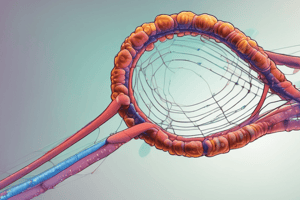Podcast
Questions and Answers
Name six different levels at which gene expression might be controlled.
Name six different levels at which gene expression might be controlled.
Alteration or modification of the gene structure at the DNA level, Transcriptional regulation, Regulation at the level of mRNA processing, Regulation of mRNA stability, Regulation of translation, Regulation by post-translational modification of the synthesized protein.
Draw a picture illustrating the general structure of an operon and identify its parts.
Draw a picture illustrating the general structure of an operon and identify its parts.
5' regulator protein gene / Promoter structural genes 3' / operator
What is the difference between positive and negative control?
What is the difference between positive and negative control?
Positive control - The regulator of the operon acts as an activator and is required in its active form for transcription. Negative control - The regulator of the operon acts as a repressor that prevents transcription when it is active.
What is the difference between inducible and repressible operons?
What is the difference between inducible and repressible operons?
What is catabolite repression? How does it allow a bacterial cell to use glucose in preference to other sugars?
What is catabolite repression? How does it allow a bacterial cell to use glucose in preference to other sugars?
What is an enhancer? How does it affect the transcription of distant genes?
What is an enhancer? How does it affect the transcription of distant genes?
Does gene S produce a repressor or an activator? Is the blob operon inducible or repressible?
Does gene S produce a repressor or an activator? Is the blob operon inducible or repressible?
Flashcards
Levels of Gene Expression Control
Levels of Gene Expression Control
Regulation of gene expression can occur at various stages, from DNA modification to post-translational changes.
Operon Structure
Operon Structure
Includes a regulatory gene, promoter, structural genes, and an operator influencing transcription.
Positive vs. Negative Control
Positive vs. Negative Control
Transcription needs an activator. Negative control: Repressor blocks transcription when active.
Inducible vs. Repressible Operons
Inducible vs. Repressible Operons
Signup and view all the flashcards
Catabolite Repression
Catabolite Repression
Signup and view all the flashcards
Enhancers
Enhancers
Signup and view all the flashcards
Blob Operon Type
Blob Operon Type
Signup and view all the flashcards
Study Notes
Gene Expression Control
- Gene expression can be regulated at multiple levels:
- DNA level: alteration or modification of gene structure
- Transcriptional regulation: control during the transcription process
- mRNA processing: control of how mRNA is spliced and modified
- mRNA stability: regulation of the lifespan of mRNA
- Translation: control of the protein synthesis process
- Post-translational modification: changes made to the protein after synthesis
Operon Structure
- An operon consists of:
- A 5' regulatory protein gene, a promoter, and structural genes
- An operator region that can influence the transcription of structural genes
Positive vs. Negative Control
- Positive control involves an activator that is necessary for transcription to occur.
- Negative control involves a repressor that inhibits transcription when active.
Inducible vs. Repressible Operons
- Inducible operons require an inducer for transcription to occur (negative or positive regulation).
- Repressible operons are typically active but can be turned off by a repressor (negative) or by the inactivation of an activator (positive).
Catabolite Repression
- Catabolite repression occurs when the presence of glucose suppresses the expression of genes for metabolizing other sugars.
- Operons involved are positively controlled by catabolic activator protein (CAP), which requires cAMP.
- Glucose levels impact cAMP inversely; increased glucose leads to lower cAMP levels, thus inhibiting CAP activation.
Enhancers
- Enhancers are DNA sequences that serve as binding sites for transcriptional activator proteins.
- They facilitate gene transcription from a distance by looping the DNA, allowing enhancer-bound proteins to interact with the promoter region.
Blob Operon Case Study
- The blob operon produces enzymes for converting compound A to compound B, regulated by gene S.
- Enzymes are synthesized only without compound B, indicating gene S likely codes for a repressor.
- The blob operon is categorized as repressible since it is inactive in the presence of compound B but active in its absence.
Studying That Suits You
Use AI to generate personalized quizzes and flashcards to suit your learning preferences.
Description
Test your understanding of gene expression control with these flashcards from Genetics Chapter 12. Each card challenges you to define concepts or illustrate structures relevant to gene regulation. Enhance your learning through active recall and visual representation.




